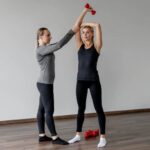Plank exercises have become increasingly popular in the fitness world due to their effectiveness in targeting and developing core muscles. But what exactly are plank exercises and why should they be a must-have in your workout routine? In this article, we will explore the importance of plank exercises and discuss the fitness components they engage.
In order to have a well-rounded fitness routine, it is crucial to understand the various components that contribute to overall physical health. This includes cardiovascular endurance, muscular strength and endurance, flexibility, and body composition. While many exercises may focus on one or more of these components, plank exercises stand out for their ability to improve core strength and stability.
Core strength plays a vital role in overall fitness as it acts as a foundation for movement and helps support the spine while promoting good posture. Plank exercises specifically target the muscles of the core, including the rectus abdominis, transversus abdominis, internal and external obliques, hip flexors, glutes, and lower back muscles. By engaging these muscles through plank exercises, you can develop not only a strong core but also improve your overall balance and stability.
As we delve deeper into this article, we will unravel the mystery behind what fitness component plank exercises fall under. Additionally, we will explore how plank exercises target and develop core muscles, improve posture and stability, enhance cardiovascular health, engage multiple muscle groups for total body strength, as well as provide mental and emotional well-being benefits.
So if you’re looking to take your fitness journey to the next level or simply want to incorporate a challenging exercise into your routine, read on to learn how plank exercises can help you achieve your goals.
Understanding the Fitness Components
What are Fitness Components?
Before we delve into the specific fitness component of plank exercises, it is important to have a basic understanding of what fitness components are. Fitness components, also known as fitness attributes or components of physical fitness, refer to different aspects of physical performance that contribute to overall fitness. These components can be divided into several categories, including cardiovascular endurance, muscular strength and endurance, flexibility, body composition, and motor skills.
The Importance of Fitness Components
Each fitness component plays a crucial role in our overall health and well-being. Cardiovascular endurance is vital for maintaining a healthy heart and lungs by increasing oxygen uptake during exercise. Muscular strength and endurance support everyday activities like lifting objects and prevent muscle atrophy.
Flexibility helps maintain joint mobility and decrease the risk of injuries. Body composition measures the ratio of fat to lean tissue in our bodies and is an important indicator of health. Lastly, motor skills encompass tasks such as balance, coordination, speed, agility, reaction time, and power – all of which are essential for various sports and daily movements.
The Role of Plank Exercises in Enhancing Fitness Components
Now that we understand the importance of fitness components let’s explore how plank exercises contribute to enhancing these components. Planks primarily target the core muscles but also engage other muscle groups throughout the body.
By holding yourself in a stable position against gravity, planks develop muscular endurance in the core muscles including the rectus abdominis (six-pack muscles), transverse abdominis (deep abdominal muscles), obliques (side abs), erector spinae (lower back muscles), and glutes (buttock muscles). This improvement in muscular endurance enhances your ability to perform daily activities with ease while reducing the risk of lower back pain and injury.
In addition to improving muscular endurance in the core region, planks also indirectly work other muscle groups such as the shoulders, arms, and legs. The muscles in these areas are required to stabilize your body during the plank, leading to increased strength and endurance. Furthermore, due to the demand on multiple muscle groups simultaneously, planks can also improve overall muscular strength and power.
The Importance of Core Strength in Fitness
The core refers to the muscles in the abdomen, pelvis, lower back, and hips. These muscles play a crucial role in maintaining stability, balance, and proper posture. A strong core is essential for overall fitness and can enhance athletic performance in various sports and activities. In this section, we will explore the importance of core strength in fitness and how plank exercises can help develop this vital aspect of physical fitness.
Enhanced Stability and Balance
A strong core is essential for maintaining stability and balance during physical activities. Whether you are running, jumping, or performing weightlifting exercises, your core muscles provide a solid foundation for movement. When your core is weak, other muscles compensate for this lack of stability, potentially leading to imbalances, overuse injuries, and poor performance. Plank exercises engage multiple core muscles simultaneously, helping to improve stability and balance.
Improved Functional Movement
Functional movements involve using multiple muscle groups together to perform everyday tasks efficiently. Having a strong core allows you to move more effectively during activities such as bending down to pick up objects or carrying heavy loads. Plank exercises target not only the superficial abdominal muscles but also the deeper stabilizing muscles that support functional movements. By strengthening these muscles through planks, you can enhance your ability to perform daily tasks with greater ease and reduced risk of injury.
Injury Prevention
A weak core can contribute to the development of various injuries during physical activity. For example, when participating in demanding sports or high-impact exercises like running or jumping, a weak core may lead to inadequate stabilization of the spine and increased stress on other joints such as the knees or shoulders. Engaging in plank exercises regularly helps strengthen the deep stabilizing muscles of the core, reducing the risk of common injuries associated with weak abdominal muscles.
By understanding the importance of core strength in fitness and how plank exercises target specific aspects of this component, you can prioritize training your core effectively. Incorporating planks into your workout routine can help improve stability, balance, functional movement, and reduce the risk of injuries commonly associated with a weak core. In the next section, we will unravel the mystery of what fitness component plank exercises truly are.
Unraveling the Mystery
Plank exercises have gained popularity in recent years due to their effectiveness in strengthening the core and improving overall fitness. But what fitness component do plank exercises fall under? To understand this, it is important to have an overview of the various fitness components.
Understanding Fitness Components
Fitness components refer to the different aspects of physical fitness that contribute to overall health and performance. These components include cardiovascular endurance, muscular strength, muscular endurance, flexibility, and body composition. Each component plays a vital role in achieving optimal physical fitness.
The Importance of Core Strength
Core strength is a fundamental aspect of physical fitness that relates to the muscles of the abdomen, pelvis, and lower back. A strong core enhances stability, balance, and posture while reducing the risk of injuries. It also improves athletic performance by providing a solid foundation for movement.
The Fitness Component of Plank Exercises
Plank exercises primarily target the core muscles, making them a key component for developing core strength. By engaging these muscles and holding a static position for an extended period, planks improve muscular endurance in the core area. They also activate surrounding muscles such as the shoulders, glutes, and legs to maintain stability during the exercise.
Planks can be classified as an exercise that falls under both muscular endurance and core strength components of physical fitness. The prolonged contraction required for maintaining the plank position challenges the muscles to sustain their effort over time, thus improving endurance. At the same time, planks specifically target the deep abdominal muscles (transverse abdominis) responsible for spinal stability and posture.
How Plank Exercises Target and Develop Core Muscles
Plank exercises are not only popular among fitness enthusiasts but also highly recommended by fitness professionals for their ability to target and develop core muscles. The core muscles, which include the rectus abdominis, transverse abdominis, obliques, and lower back muscles, play a crucial role in providing stability, balance, and overall strength to the body.
When performing plank exercises, multiple muscle groups within the core are engaged simultaneously. This is because the plank position requires you to maintain a straight line from your head to your heels, which activates the entire abdominal region. Additionally, plank exercises also engage other muscles such as the shoulders, chest, glutes, and legs to maintain stability and support the body during the exercise.
One of the main reasons why plank exercises are effective in targeting and developing core muscles is because they require isometric contractions. Isometric contractions involve holding a static position without any movement or changing muscle length. During planks, you contract your core muscles without any joint movement or bending at the waist. This sustained contraction forces your core muscles to work harder and become stronger over time.
To fully understand how plank exercises target and develop core muscles, it is essential to break down each component of the exercise. The starting position of a traditional plank is similar to holding a push-up position with extended arms. As you hold this position, your transverse abdominis engages to stabilize your spine while preventing excessive arching in the lower back. Simultaneously, your rectus abdominis contracts to keep your torso stable and aligned.
To enhance the effectiveness of plank exercises for targeting and developing core muscles further, various modifications can be made based on fitness levels and goals. Advanced variations such as side planks or single-leg planks can increase intensity by placing greater emphasis on specific muscle groups within the core region. It’s important to note that beginners should start with basic planks before progressing onto more challenging variations.
Incorporating plank exercises into your fitness regimen is a surefire way to strengthen your core muscles, improve balance and stability, and enhance overall body strength. So whether you are an athlete looking to enhance performance or someone seeking better functional movement in everyday life, including plank exercises in your workout routine is a must.
The Role of Plank Exercises in Improving Posture and Stability
Plank exercises are not only beneficial for strengthening the core and improving cardiovascular health, but they also play a crucial role in improving posture and stability. Good posture and proper body alignment are essential for preventing injury, reducing musculoskeletal pain, and enhancing overall physical performance.
When performing plank exercises, it is important to maintain proper form and alignment throughout the exercise. This means keeping the body in a straight line from the head to the heels, with shoulders stacked above the wrists or elbows (depending on the variation of the plank). By holding this position, various muscles throughout the body are engaged to support and stabilize the spine.
One of the main muscle groups that benefit from plank exercises in terms of posture improvement is the back muscles. Planks help strengthen the erector spinae muscles, which run along both sides of the spine and help maintain good posture. When these muscles are weak or imbalanced, it can lead to poor posture, rounded shoulders, and subsequent back pain. Regularly incorporating planks into your workout routine can help correct these imbalances by strengthening these muscles.
In addition to back muscles, plank exercises also engage other important stabilizing muscles such as the glutes, hips, and shoulder girdle. By developing strength in these areas through plank variations like side planks or extended arm planks, you improve overall stability and reduce likelihood of injury during daily activities or while participating in other forms of physical exercise.
| Benefit | Muscles Engaged |
|---|---|
| Improves Posture | Erector Spinae Muscles (back) |
| Enhances Stability | Glutes; Hips; Shoulder Girdle |
Planks and Cardiovascular Health
Cardiovascular health is an essential aspect of overall fitness, and it encompasses the health and efficiency of the heart, blood vessels, and lungs. While planks are primarily known for their ability to strengthen the core muscles, they also have a positive impact on cardiovascular health. In this section, we will explore the connection between planks and cardiovascular health.
One way that planks contribute to cardiovascular health is by increasing heart rate. When performing a plank exercise, multiple muscle groups are engaged simultaneously, resulting in an increased demand for oxygen and energy. This increased demand prompts the heart to pump more blood throughout the body to deliver oxygen and nutrients to the working muscles.
In addition to raising heart rate, planks also improve circulation. As muscles contract during a plank, blood flow is enhanced in the surrounding tissues. Over time, this improved circulation helps to promote healthier blood vessels and reduce the risk of conditions such as high blood pressure and arterial damage.
Here are some key ways that planks benefit cardiovascular health
- Increasing heart rate
- Improving circulation
- Reducing the risk of cardiovascular diseases
- Promoting overall cardiovascular endurance
- Aiding in weight management
It is important to note that while planks can contribute positively to cardiovascular health, they should not be the sole form of exercise for maintaining or improving overall cardiovascular fitness. It is recommended to include other forms of aerobic exercise such as running, swimming, or cycling in your fitness routine to achieve optimal cardiovascular benefits.
In summary, incorporating plank exercises into your workout routine can provide significant benefits beyond just core strength. By raising heart rate and improving circulation, planks contribute positively to your overall cardiovascular health. Remember to consult with a healthcare professional or certified fitness trainer before starting any new exercise program if you have pre-existing medical conditions or concerns about your cardiac health.
Planks for Total Body Strength
Plank exercises are not just for improving core strength, but they also engage multiple muscle groups throughout the body. When performing plank exercises, various muscles work in synergy to maintain stability and proper form. This comprehensive engagement of muscles makes planks an effective exercise for building total body strength.
One of the primary muscle groups that plank exercises target is the upper body, particularly the shoulders, chest, and arms. As you hold a plank position, your arms are supporting your body weight and maintaining stability, which helps to build strength and endurance in the arm muscles. Additionally, the chest muscles are engaged as they work to stabilize the shoulder joints during the exercise.
In addition to targeting the upper body, plank exercises also engage the lower body muscles. The leg muscles, including the quadriceps and hamstrings, act as stabilizers throughout the exercise to help maintain balance and support your body weight. The glutes are also activated while holding a plank position as they work to stabilize and maintain proper alignment of the hips.
Furthermore, plank exercises engage the back muscles, specifically the erector spinae which run along either side of the spine. These muscles play a crucial role in maintaining proper posture and spinal alignment during plank exercises. Strengthening these back muscles can contribute to improved posture and help alleviate back pain caused by poor muscular support.
| Muscle Group | Role during Plank Exercises |
|---|---|
| Upper Body (Shoulders, Chest, Arms) | Supporting body weight and maintaining stability |
| Lower Body (Legs and Glutes) | Stabilizing balance and supporting body weight |
| Back (Erector Spinae) | Maintaining proper posture and spinal alignment |
Including plank exercises in your fitness routine can help you build overall strength and enhance muscular endurance across various muscle groups. Whether you are looking to tone your upper body, strengthen your lower body, or improve your posture, planks provide a versatile and effective workout option.
Benefits Beyond the Body
Plank exercises are renowned for their physical benefits, such as improving core strength, posture, and overall stability. However, the benefits of planks go beyond just the body. Engaging in plank exercises can also have a positive impact on one’s mental and emotional well-being.
Physical activity has long been associated with improved mental health and emotional well-being. Exercise releases endorphins, which are commonly referred to as “feel-good” hormones. These chemicals in the brain help reduce feelings of pain and stress while promoting feelings of happiness and euphoria. Plank exercises, as part of a regular fitness routine, can stimulate the release of endorphins, contributing to improved mood and overall well-being.
Moreover, plank exercises require concentration and mental focus. Holding a proper plank position challenges your mind to stay engaged and maintain balance. This mental engagement can help shift your attention away from negative thoughts or worries. By focusing on your form and breath during planks, you can experience a sense of mindfulness that promotes relaxation and reduces anxiety.
In addition to its mental benefits, planks also have a positive impact on emotional well-being. Regular physical activity has been linked to reduced symptoms of depression and anxiety. By incorporating plank exercises into your fitness regimen, you not only strengthen your body but also provide yourself with an opportunity for emotional release and relief from daily stressors.
To summarize, the benefits of plank exercises extend beyond just physical fitness. Engaging in regular planking can promote mental clarity, reduce stress levels, improve mood, and enhance overall emotional well-being. By incorporating this exercise into your fitness routine, you are not only working towards achieving a stronger body but also fostering a healthier mind.
| Benefits Beyond the Body | Mental & Emotional Well-being |
|---|---|
| Release of endorphins | Reduces stress and promotes happiness |
| Mental engagement | Promotes mindfulness and reduces anxiety |
| Reduces symptoms of depression and anxiety | Provides emotional release and relief from daily stressors |
Incorporating Plank Exercises into Your Fitness Regimen
Plank exercises are a versatile and effective way to improve your overall fitness level. Whether you’re a beginner or a seasoned fitness enthusiast, incorporating plank exercises into your workout routine can have numerous benefits. In this section, we will explore some tips and techniques to help you effectively incorporate plank exercises into your fitness regimen.
- Start with proper form: Before attempting any plank variation, it’s crucial to understand the correct form to avoid injury and maximize the benefits. Begin by placing your forearms on the floor, shoulder-width apart, with your elbows directly below your shoulders.
Extend your legs behind you, one at a time, until you are in a push-up or full plank position. Engage your core by pulling your belly button towards your spine and hold this position for as long as you can. - Gradually increase duration and difficulty: As with any exercise, it’s important to start at an appropriate level of difficulty and gradually progress over time. Begin with shorter durations, such as 30 seconds, and gradually increase the time as your strength improves. Once you can hold a basic plank for one minute or longer, challenge yourself by trying different variations such as side planks or elevated planks.
- Mix it up with variations: Plank exercises offer a wide variety of variations that target different muscle groups and add variety to your routine. Some popular variations include side planks, reverse planks, knee-to-elbow planks, and forearm planks with leg lifts. Experiment with different variations to target specific areas of the core and prevent boredom in your workouts.
- Incorporate plank circuits: To further enhance the effectiveness of plank exercises, consider incorporating them into circuit training routines. Combine various exercises such as squats, lunges, push-ups,and jumps with different forms of planks for a full-body workout that builds strength and endurance.
Remember, consistency is key when incorporating plank exercises into your fitness regimen. Aim to perform planks at least 2-3 times a week, gradually increasing the duration and difficulty as your strength improves. By following these tips and techniques, you can harness the full potential of plank exercises and achieve your fitness goals. So, get ready to embrace the planking journey and take your fitness to new heights.
Conclusion
In conclusion, incorporating plank exercises into your fitness regimen is a must if you want to achieve your fitness goals. Planks target and develop core muscles, improving core strength, stability, and posture. This not only helps in everyday movements but also benefits other areas of fitness such as cardiovascular health and total body strength.
One of the main reasons why plank exercises are so effective is because they engage multiple muscle groups at once. By holding a plank position, you not only work your core but also activate your arms, shoulders, back, and legs. This makes planks a great addition to any full-body workout routine and can help you build overall strength.
However, the benefits of incorporating plank exercises go beyond just physical gains. Planking also has positive effects on mental and emotional well-being. The focus required to hold a plank position can help improve concentration and mindfulness. Additionally, the sense of accomplishment that comes from gradually increasing your plank time can boost self-esteem and motivation.
To incorporate planks into your fitness regimen effectively, it is important to start with proper form and technique. Begin with shorter holds and gradually increase the duration as you become more comfortable. You can also try variations of planks to challenge yourself further and prevent boredom.
Frequently Asked Questions
What fitness component is planks?
Planks primarily target the fitness component of core strength. When performing planks, the muscles in the abdomen, lower back, and hips are engaged to stabilize the spine and maintain a straight line from head to toe.
This exercise places emphasis on strengthening the deep muscles of the core, such as the rectus abdominis, transverse abdominis, and obliques. By challenging these muscle groups, planks help improve overall core stability and muscular strength.
Is plank cardio or muscular endurance?
Planks are considered more of a muscular endurance exercise rather than cardio. Muscular endurance refers to the ability of a muscle or group of muscles to sustain repeated contractions over an extended period without fatigue.
During planks, you hold a static position for an extended period, which increases muscular endurance in not only your core but also your shoulders, arms, and legs depending on variations. While planks can slightly elevate your heart rate due to engaging multiple muscles at once, it does not provide cardiovascular benefits comparable to activities like running or cycling.
What are the components of planks?
The components of planks primarily involve engaging various muscle groups throughout the body. The main focus is on activating and strengthening the core muscles mentioned earlier – rectus abdominis, transverse abdominis, and obliques – to stabilize the spine and maintain proper posture during the exercise.
Additionally, planks engage the glutes (butt muscles), quadriceps (front thigh muscles), hamstrings (back thigh muscles), deltoids (shoulder muscles), trapezius (upper back muscles), rhomboids (middle back muscles), and erector spinae (lower back muscles). These different muscle groups work together to provide stability and support during plank exercises while enhancing overall strength and posture.

Passionate about providing useful information to anyone with an interest in the field of Personal Training, I strive to pass on to our readers quality information and to answer any questions about Personal Trainers, the work they do and how to become one.





